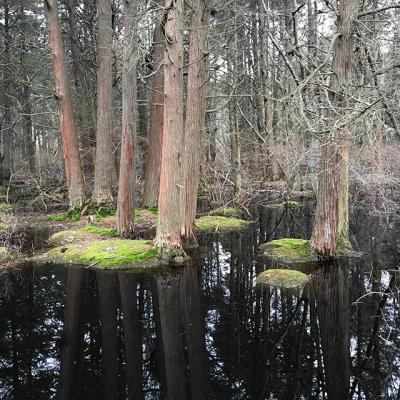Nature Notes: Rare Wonders

Victoria Bustamante and her college-age son Chris visited one of the Atlantic white cedar swamps on Friday. There are four in North Sea, three on the north side of Little Fresh Pond and one on the south side. Conifers that do well with roots in standing water are rare across the globe and white cedars are our only native conifer with such a habit. In fact you almost never find one doing well on dry land.
Because they live and die in water-filled holes, colonists early on discovered that if you probe into these boggy spots your probes will often hit hard objects, and when such a hard object is brought to the surface, it is generally the trunk of a dead white cedar. When the bole is examined, it turns out that it shows little sign of rot, even after hundreds of years, and as shingles and shakes became the covering for colonist houses along the Atlantic Coast, the best ones were fashioned from such water-logged boles.
Small mossy hummocks are frequently found around the bases of the cedars and sometimes they serve as substrate for wetland species such as lilies and orchids. A few wetland shrubs line the shores and it was at the edge of one of these three cedar swamps that Vicki Bustamante and I found swamp sweet bells in bloom. To date it is the farthest east spot on the South Fork where we have found this shrub.
There is another Atlantic white cedar grove a bit farther east in the northern part of a Nature Conservancy sanctuary, Sagg Swamp, north of Sagaponack Pond at the south end of the Long Pond Greenbelt. Even though such white cedar swamps have existed on Long Island since the time of the earliest settlers, the Native Americans, not a lot is known about them. In this millennium John Turner, one of the four original members who started the Long Island Pine Barrens Society and a biologist who is now part of the Seatuck Environmental Association in Islip, visited each one and wrote a book about them. (It was that same group that did much of the original work on our pitch pine-dominated pine barrens, and whose work eventually led to protecting almost 80,000 acres of them. In fact, the only Long Island pitch barrens not protected are east of the Hampton Bays canal in Southampton and East Hampton Towns.)
Ms. Bustamante has raised a few Atlantic white cedars in a Warren’s Nursery greenhouse and has since replanted them in the wild. A single quite large one grew along the west edge of a small pond and wetland just west of Audubon Lane in Bridgehampton, but after it was identified in 2012, Superstorm Sandy came along and knocked it down. There were no other white cedar trees at that spot to protect it.
According to Vicki, as of Friday the water surrounding the white cedars was very dark and clear, with no aquatic plants or plankton growing in it, perhaps because it is so shaded over by the tall evergreen foliage above. I wonder how these cedar bogs have persisted so long; there are several houses not too far away from them. Interestingly, although several southern bird species are back, Vicki and Chris heard only one calling — possibly a titmouse. No spring peepers were chirping, notwithstanding the fact that other watery spots have enjoyed their calls for almost two weeks now. Although I’ve tried several times at different times of the year, I have never found frogs or salamanders in these ponds, maybe because there is little for the tadpoles to feed on.
In the 1980s I wrote about these cedar bogs for The Star, accompanied by a photo of a large white cedar taken by the photographer Rameshwar Das. I also aged one that turned out to be more than 100 years old.
What is scary is that as of 2018 on the south side of Little Fresh Pond, there is at least one mature Atlantic white cedar and many many seedling ones less
than a foot high. Scary, because the Southampton Town Zoning Board has just approved a change of status for the tennis facility at that spot, which would make its primary use a summer camp — the Southampton Country Day Camp — for as many as 500 children and their counselors despite the fact that just about everyone living in the small family houses around the pond is against it. The pond is already deemed “impaired” by the New York State Department of Environmental Conservation. The Surfrider Foundation, along with the Peconic Baykeeper and Concerned Citizens of Montauk, have been regularly sampling its water for several years running now for the intestinal bacteria flora enterococcus, and have found dangerous values of it, to the point where the D.E.C. says the pond should not be used for swimming or water sports.
There is a would-be twist to the zoning board’s recent decision. The owner of the camp is Jay Jacobs, chairman of the New York State Democratic Committee, who also owns camps in East Hampton and elsewhere on Long Island. He personally attended several of the zoning board meetings having to do with the camp. The head of the zoning board is a Democrat and four of the town board members are Democrats. One wonders if the business of politics is coming before the business of nature?
Larry Penny can be reached via email at [email protected].
